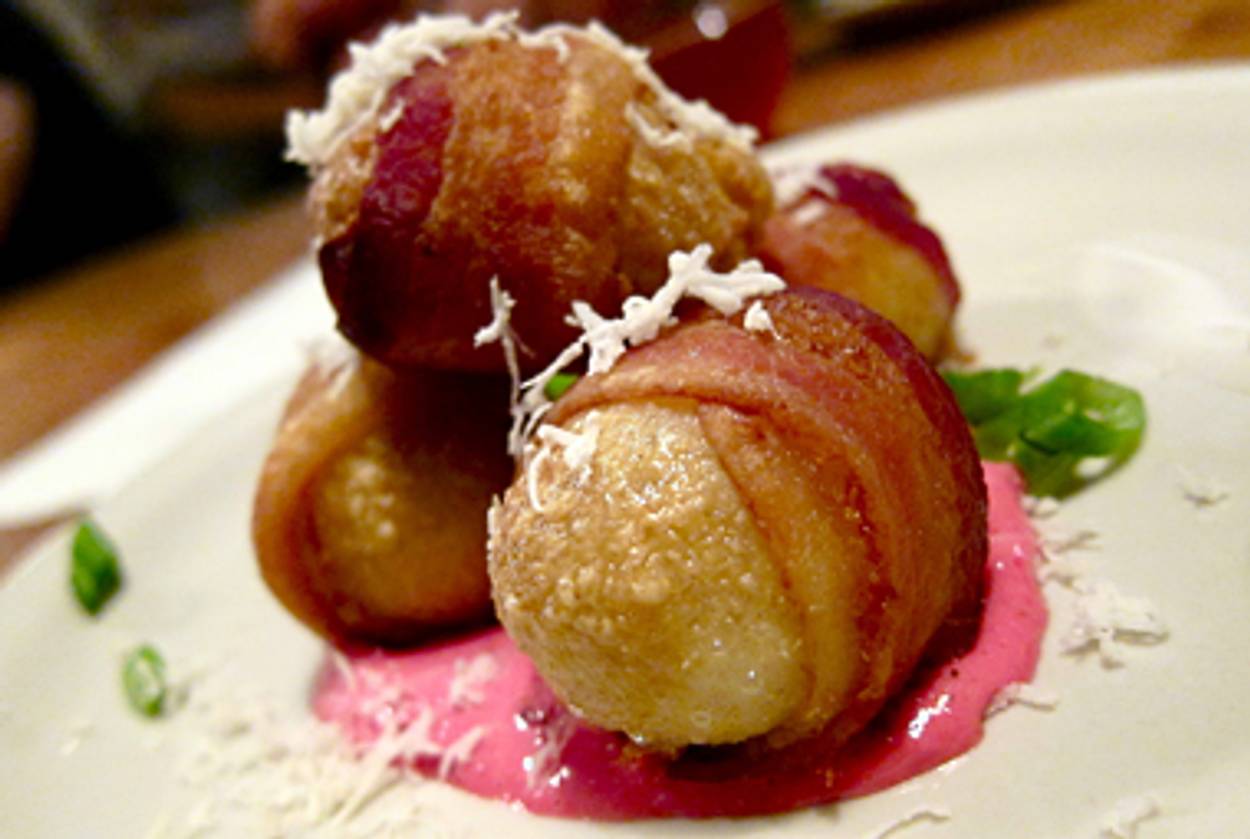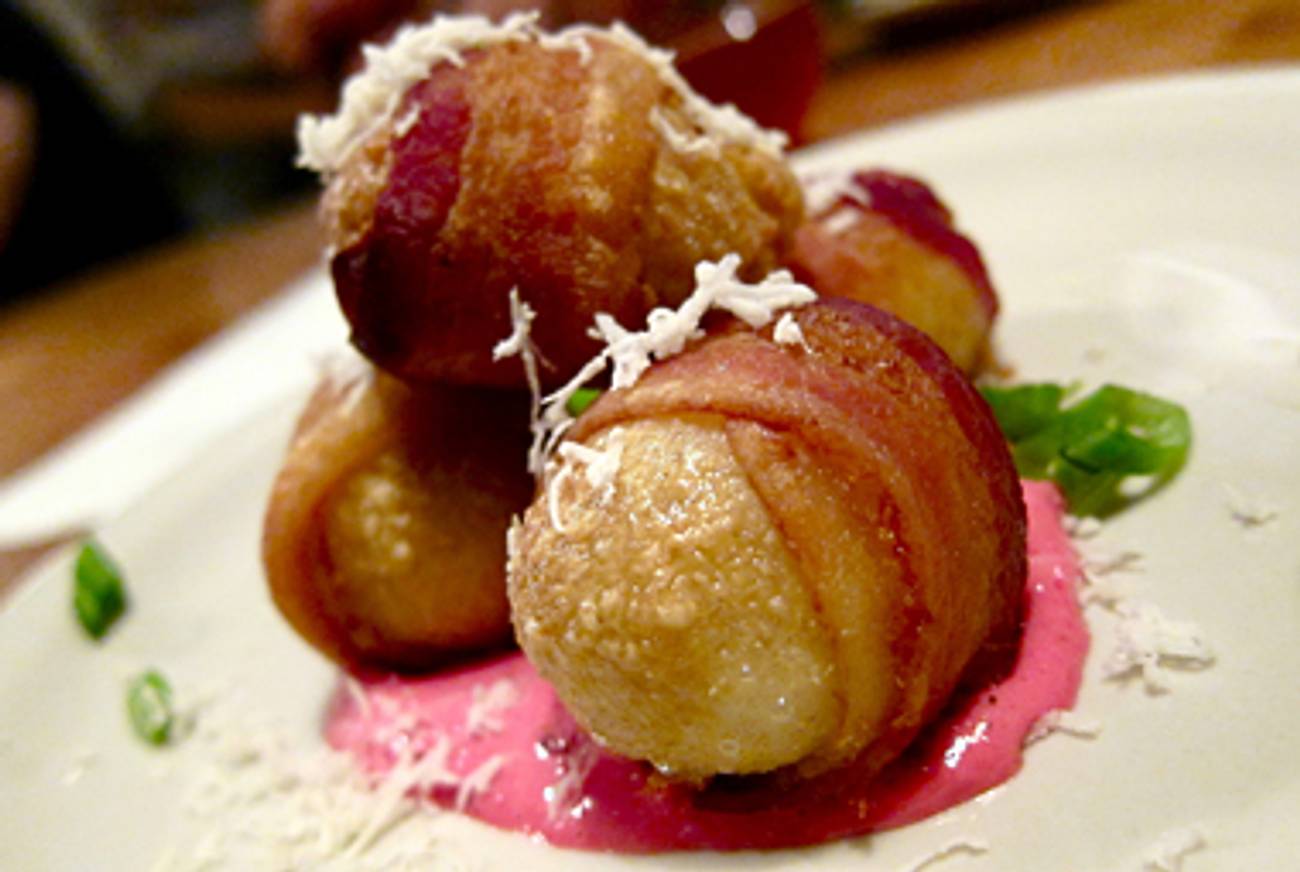Unkosher
Restaurants offering dishes like bacon-wrapped matzo balls are garnering praise for embracing Jewish tradition while also rejecting it. But a chef turned rabbinical student suspects they’re just lazy.




The Jewish culinary tradition is a hot trend in American dining. At Brooklyn’s Mile End Noah Bernamoff and Aaron Israel serve up cholent with veal shortribs and kasha varnishkes with confit gizzards. At the impishly named Traif, also in Brooklyn, Chef Jason Marcus—who describes himself as “Jewish, although obviously not great at it”—focuses on pork and shellfish. At his Los Angeles restaurant The Gorbals, Top Chef winner Ilan Hall gussies up matzo balls by wrapping them in bacon. “Pork fat does something magical to matzah meal,” Hall told the Jewish Journal in November.
Jewish food that actively thumbs its nose at the laws of kashrut clearly holds tremendous social allure for some. As Jeffrey Yoskowitz wrote in theAtlantic, Traif’s Marcus “is counting on other Jews to hear about his restaurant and think, ‘Cool, I’m a non-kosher Jew too.’ ” Indeed, most of the critical praise earned by establishments like Traif and Mile End has highlighted—knowingly or not—the clever disjuncture of embracing Jewishness while simultaneously rebelling against it. Thus when the New York Times fawned over Traif’s “seared foie gras, slumming it with fingerling potatoes, crisp shards of ham, and a fried egg, all dribbled with maple syrup and hot sauce,” the reviewer, Ligaya Mishan, had to add: “Now this is chutzpah.”
Before starting rabbinical school at the Jewish Theological Seminary in 2009, I put in time behind the stoves at Telepan on Manhattan’s Upper West Side, where I smoked upward of 5,000 trout, and at Restaurant Saul, in Brooklyn, not far from Mile End, where I once cooked by candlelight when the block lost power in the middle of dinner service. At the time I was working in kitchens I was not observant—and I therefore ate just about every abomination in the book. I also learned all the tricks at chefs’ disposals. But now I know some of the rabbis’ tricks, too, and, with this dual knowledge, I can’t help but see the menus offered up by this new generation of trayf-worshippers as lazy—not religiously, necessarily, but culinarily.
****
Traditional Jewish foods, mostly of Ashkenazi origins, have been cropping up on the American culinary landscape for more than a century. For most of that time, their makers have frequently disregarded the dietary restrictions that historically characterized Jewish eating. (The Carnegie Deli, founded in 1937, has been slinging matzo brei alongside ham and eggs for decades.) Neither these older restaurateurs nor their contemporary counterparts are interested in kashrut—to say nothing of their customers. Rather, as Leah Koenig, author of The Hadassah Everyday Cookbook, told me, they aim to “celebrate Jewish heritage and cuisine in a broader more global context.” They aren’t concerned with the ritual specificity of traditional Jewish eating, and they divorce themselves from the emphasis on inwardness, on home and hearth, that has been an integral part of Jewish cookery for thousands of years.
But is such a disjuncture really possible? The game of baseball, for instance, only makes sense within a certain framework—of three strikes, three outs, nine players, four bases. Could you hit a ball with a tennis racket instead of a bat and still, with integrity, call it baseball? To call food “Jewish” only makes sense in the context of what “Jewish” has meant throughout history. That history has included innovation and change, but it has also included a crucial element of preservation and repetition.
This isn’t a religious argument. The best “Jewish food” has historically been created by Jewish cooks who were trying, simultaneously, to preserve and innovate. One of the staples in the Ashkenazi Jewish larder, for example, was schmaltz. Usually made by rendering chicken or goose fat (the leftover crispy bits, called gribenes, became a delicacy in their own right), schmaltz was an essential element of Ashkenazi cookery because frying meat in butter is forbidden, and the Jewish communities of Eastern Europe didn’t have ready access to non-dairy alternatives (like sesame and olive oil) that were common in the Mizrahi world. Eventually, in an effort to produce more and more goose fat, Jews began over-feeding their birds. In addition to ramping up the rate of gribenes consumption (and perhaps the rate of heart attacks) among Ashkenazi Jews, the process of force-feeding geese produced an inadvertent by-product—foie gras, which would go on to become a cornerstone of haute-French gastronomy. Although fattened goose liver was a well-known delicacy in the ancient world (the Talmud actually mentions the process of intentionally fattening geese), it was subsequently lost to European cuisine until 16th century, when, as Michael Ginor writes in Foie Gras: A Passion, renaissance chefs, looking to expand their culinary repertoires, started exploring butcher shops in the Jewish ghettos.
And so, while Jewish cooking has always been driven by cultural exchange, it has also, crucially, been influenced just as much by cultural boundaries—which dictated that Jews participate in a shared ritual system, through which the meal became an opportunity to reify and reinforce one’s commitment to a certain way of life.
Thus, the incorporation of outside cuisines also included their adaptation to the dietary restrictions of kashrut—which is how someone came up with the idea to cover toast in schmaltz instead butter, which couldn’t be eaten with meat meals—or to the rhythms of Jewish life, which inspired the one-pot braise known as cholent that was meant to cook all day on the blech.
The early rabbis made the laws surrounding kashrut more stringent precisely to ensure that Jews and non-Jews never ate meals with one another. In a section of the Babylonian Talmud dealing with idolatrous practice, Rabbi Kahana says that while bread baked by a non-Jew is not forbidden according to the Torah, the rabbis forbade it nonetheless. Bread being fundamental to a proper, halakhic meal, traditional rabbinic thought understands this prohibition in terms of an overarching effort to prevent Jews and non-Jews from ever developing close relationships. While reasonable people can certainly disagree about the wisdom of this sort of mandated cultural insularity, the fact remains that rabbinic stringencies have left on indelible imprint on Jewish cookery. Culinary traditions around the world use braises, but they occupy such a central place in Jewish cookery because they provide solutions to the restrictions of cooking on Shabbat. And many cultures around the world produce rich, celebratory egg breads (the Czechs’ Hoska, often eaten around Christmastime, is even braided), but their recipes almost invariably include milk. Because most Jewish communities have a strong tradition of eating meat on festive occasions (indeed, there is a statement in the Talmud that says there can be no celebration without meat), Jewish egg-bread leaves the milk out, an omission that makes the loaf heavier and gives challah its signature chew.
****
To be sure, it is possible to inflect non-kosher food with Jewish culinary influences. These inflections often speak of genuine cultural exchange. The offerings at Telepan, my former employer, include not only smoked trout, but brunch options like the “Upper West Sider” (smoked salmon, gravlax, scrambled eggs, whitefish salad, and a mini bagel with cream cheese), and “babka-style” French toast. What my old boss is doing is exploring Jewish cookery by riffing on Jewish dishes that have already entered the broader cultural lexicon—a lexicon in which knishes stride alongside sushi, lo mein, and pork belly. He’s not interested in an ironic, self-consciously hip return to one’s roots, the subversive frisson evinced by Mile End’s breakfast sandwich, a dish that includes bacon and calls it “chazzer.”
More than 100 years after the founding of Bagel Bakers Local 338, a Manhattan trade union comprised of Yiddish-speaking bagel makers, celebrated chef Wylie Dufrense opened up shop on the Lower East Side and made an everything bagel out of ice cream and served it with smoked salmon threads. He did not, however, throw pancetta in the dish.
By abandoning the uncomfortable tension that comes from pushing to innovate while also striving to preserve, many young Jewish chefs are balking at the challenge inherent in creating truly new Jewish food—the kind of food that is so successful, so popular, and so Jewish that it finds its way into the collective imagination of an entire people and takes its place among their ever-evolving traditions. Six generations hence, Jewish culinary lights, out of an inevitable desire to reshape Jewish cuisine according to their own visions and contexts, will have to reinterpret whatever we pass on to them. But what will be our current legacy? Where do you go from bacon cholent?
Benjamin Resnick is a rabbinical student at the Jewish Theological Seminary.
Benjamin Resnick is a rabbinical student at the Jewish Theological Seminary.